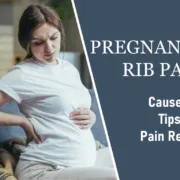Round Ligament Pain Stretches and other Remedies for Relief
Round ligament pain is a common complaint during pregnancy, especially in the second trimester. It is often experienced as a sharp or pulling pain in the lower abdomen or groin, usually triggered by sudden movements such as standing up quickly, sneezing, or coughing. While this pain can be concerning, it is a normal part of pregnancy and rarely indicates any serious problem. Understanding its causes, symptoms, and treatments can help in managing discomfort and reducing unnecessary anxiety.
What is the Round Ligament?
The round ligament is a pair of rope-like structures that support the uterus. These ligaments start at the top of the uterus, pass through the pelvis, and attach to the labia majora (part of the external female genitalia). Their primary function is to maintain the position of the uterus in the pelvis. In non-pregnant individuals, the round ligaments are relatively short and flexible, allowing for subtle movements. However, during pregnancy, as the uterus grows, the round ligaments stretch and thin to accommodate the expansion, which can lead to pain.
What is Round Ligament Pain?
Round ligament pain occurs when these ligaments are overstretched or strained. The pain is most commonly felt in the lower abdomen or groin area and can be sharp, stabbing, or aching. The pain is typically brought on by sudden movements, such as standing up too quickly, rolling over in bed, sneezing, or coughing. While it can be uncomfortable, round ligament pain is generally short-lived and harmless.
Causes of Round Ligament Pain
The primary cause of round ligament pain is the stretching of the ligaments as the uterus grows. Normally, the ligaments stretch slowly, allowing for gradual changes. However, sudden movements can cause the ligaments to contract quickly, leading to pain. Hormonal changes during pregnancy, particularly the hormone relaxin, also play a role in softening the ligaments, making them more prone to strain.
Round ligament pain is most common during the second trimester when the uterus starts to expand out of the pelvis. It is also more likely in women who are pregnant with multiples or who have had multiple pregnancies. Those with a smaller or petite frame might also experience more severe round ligament pain.
Can Round Ligament Pain Happen When You’re Not Pregnant?
Although rare, round ligament pain can occur even when you’re not pregnant. Conditions like endometriosis, where tissue similar to the uterine lining grows outside the uterus, can cause pain in the round ligaments. This can result in pelvic pain, discomfort during sex, painful periods, and even infertility. Additionally, certain physical activities or trauma to the pelvic region can irritate or overstretch the round ligaments, causing pain.
What Does Round Ligament Pain in Pregnancy Feels like?

Round ligament pain is usually described as a sharp, stabbing, or cramping sensation in the lower abdomen or groin, often on one side of the body but sometimes on both. It can also radiate down into the hips and thighs. The pain is typically triggered by sudden movements and usually lasts for only a few seconds or minutes.
Common triggers for round ligament pain include:
- Sudden movements such as standing up or sitting down quickly.
- Coughing, sneezing, or laughing.
- Rolling over in bed.
- Engaging in physical activity or exercise.
Is Round Ligament Pain Dangerous?
While round ligament pain can be uncomfortable, it is generally not dangerous. However, it’s important to differentiate between normal round ligament pain and other causes of abdominal pain that could signal a more serious condition, such as ectopic pregnancy, miscarriage, or preterm labor.
If you experience any of the following symptoms along with round ligament pain, contact your healthcare provider immediately:
- Severe or persistent abdominal pain.
- Vaginal bleeding or spotting.
- Fever, chills, or nausea.
- Painful urination or changes in vaginal discharge.
- Cramping that doesn’t improve with rest.
Treatment for Round Ligament Pain
The best way to relieve round ligament pain is through rest and gentle stretching. Changing positions slowly can also help the ligaments stretch gradually, reducing the likelihood of pain.
Here are some additional tips to help relieve discomfort:
- Support your belly: Use a belly band or maternity belt to provide extra support to your growing abdomen and reduce ligament strain. Wearing compression garments designed for pregnancy can also reduce the tension on your ligaments.
- Rest: Take frequent breaks, especially if you’re standing or walking for long periods. Lying down for a few minutes when you feel pain can help alleviate the discomfort.
- Warm baths: A warm bath (not too hot) can help relax your muscles and ease ligament pain. Warm compresses on the painful area can also provide relief.
- Position changes: Move slowly when changing positions to avoid sudden stretching of the ligaments.
- Over-the-counter medication: If the pain is severe, ask your healthcare provider if you can take acetaminophen to manage the discomfort. Avoid NSAIDs like ibuprofen, which are not recommended during pregnancy.
- Pillow support: When lying down, try placing a pillow between your knees or under your belly for added support. A pregnancy pillow can be especially helpful in reducing discomfort during sleep.
Round Ligament Pain Stretches
Gentle stretching exercises can help relieve round ligament pain and prevent it from recurring. Below are a few stretches that are safe to perform during pregnancy and can provide relief:
1. Kneeling Hip Flexor Stretch
- Start by kneeling on the floor in a lunge position with one foot forward and the other knee on the ground.
- Keep your back straight and slowly push your hips forward, feeling a stretch in the front of your hip on the side where your knee is on the ground.
- Hold the stretch for 20 to 30 seconds, then switch sides.
- Ensure you don’t over-extend your back to avoid additional strain. Focus on moving your hips forward rather than arching your lower back.
2. Seated Adductor Stretch
- Sit on a chair with your feet flat on the floor and slightly apart.
- Extend one leg to the side while keeping your heel on the ground.
- Turn your upper body towards your bent knee and gently lean forward until you feel a stretch in your inner thigh.
- Hold the position for 20 to 30 seconds, then switch sides.
- Be mindful of your posture by keeping your spine long and shoulders relaxed as you lean forward.
3. Pelvic Tilts on an Exercise Ball
- Sit on an exercise ball with your feet firmly on the ground, hip-width apart.
- Engage your core and gently tilt your pelvis forward, arching your lower back.
- Then tilt your pelvis back, pressing your lower back into the ball.
- Repeat this motion 10 times in a slow, controlled manner.
- This stretch helps alleviate tension in the lower back and can strengthen the pelvic area, supporting the ligaments.
4. Tail Wag Stretch
- Get on all fours, with your hands directly under your shoulders and your knees under your hips.
- Gently engage your core and move your hips to one side, trying to bring your shoulder and hip towards each other.
- Hold for a few seconds, then switch sides.
- Repeat 5-10 times on each side.
- This stretch is effective for relieving lower back tension, which can contribute to round ligament discomfort.
Frequently Asked Questions (FAQs)
Can you have round ligament pain when you’re not pregnant?
Yes, it is possible. Round ligament pain can occur in non-pregnant individuals, often due to endometriosis, where abnormal tissue growth leads to pelvic pain. Physical activities or trauma may also irritate the ligaments.
When does round ligament pain start during pregnancy?
Round ligament pain usually starts in the second trimester, around the 13th to 16th week of pregnancy, as the uterus expands beyond the pelvis. However, some women may experience it earlier or throughout pregnancy.
How long does round ligament pain last?
The pain can last for a few seconds to a few minutes. It typically goes away by the third trimester as the uterus stabilizes, but it can persist throughout pregnancy in some cases.
Will round ligament pain harm my baby?
No, round ligament pain is not harmful to you or your baby. It is a common and normal symptom experienced during pregnancy, often resulting from the stretching and adjusting of ligaments as your body accommodates the growing fetus.
Will I continue to experience round ligament pain postpartum?
Typically, round ligament pain resolves after delivery. Once you give birth, your uterus and round ligaments gradually return to their pre-pregnancy size, alleviating any discomfort. However, if you experience similar pain postpartum when you are not pregnant, it may be uncommon and could indicate a condition like endometriosis. In such cases, it is important to seek medical advice.
Can round ligament pain be prevented?
While you can’t always prevent round ligament pain, moving slowly and avoiding sudden movements can reduce your chances of triggering it. Stretching and using a maternity belt for support can also help alleviate discomfort.
Conclusion
Round ligament pain is a common and usually harmless part of pregnancy. By understanding its causes, symptoms, and treatment options, you can better manage the discomfort. Rest, stretching, and supportive measures can help ease the pain and prevent it from interfering with your daily activities. If the pain becomes severe or is accompanied by other concerning symptoms, always consult your healthcare provider to rule out any serious conditions.










